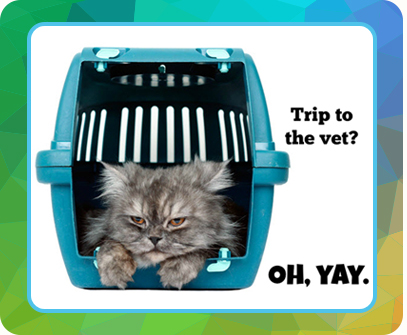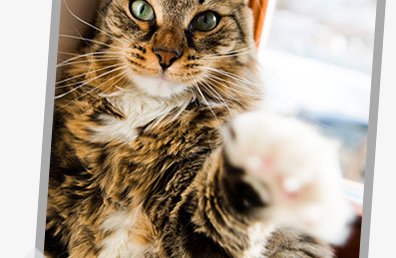 |
 |
|
 |
 |
 |
They rule the internet and are the most commonly owned pet, so it may seem like cats have it made in the kitty shade, right? Unfortunately, not so. In fact, most pet cats actually don't receive the veterinary care they need and deserve throughout their lives. Sad, isn’t it? Especially when you consider how many great things they bring to our lives: the purrs, the head bonks, the lap naps, the hairbal-- okay, granted, some things are greater than others.
It’s time for us to change the way we think. Let’s dispel the old “cats are self-sufficient ” myth and realize that just as we need our beloved cats for love and companionship, they need us humans just as much. And one of the most important, basic needs our cats have is regular veterinary care.
Not just when they’re sick or injured.
Not just when they’re due for a vaccine.
Not just when it’s time to say goodbye.
Cats need – at the minimum – annual preventive care check-ups with your veterinarian to make sure they’re healthy, to check for early signs of illnesses and problems, to discuss any behavioral issues, and to review all the great things you’re doing at home to keep your cat healthy and happy.
Read on for more details on why preventive care check-ups are so important – plus we’ll help you solve that age-old mystery: how to get your cat to your veterinarian’s office with the least amount of stress (for both of you!). |
|
 |
|
 |
 |
Cats are great actors (think Oscar-winning great) and hide symptoms of illness. This natural cat behavior make it easy for cat owners to miss signs of illness until their cat is very sick. Preventive care check-ups let your veterinarian check for subtle signs of developing issues and recommend treatment. |
 |
This one’s a two-fer: early diagnosis of problems is best for your cat’s prognosis, comfort, and for your wallet! Illness and conditions are generally more treatable, and with less dramatic and expensive intervention, when they're caught early.
|
 |
Is your cat indoors only? Great! But that doesn’t make him or her impervious to feline viruses, and walls are no protection against non-viral diseases like dental disease and diabetes. |
|
 |
 |
Many common feline issues, like urinating outside the litterbox, can be misconstrued by cat owners as a behavioral issue when it’s actually a physical problem. A preventive care check-up is an opportunity to identify and treat the problem appropriately. |
 |
Cats age much more quickly than we do. By the time they hit 1 year old, they’re about 15 in human years (and begging for their learner’s permit, no doubt). At 5 years old, they’re about 36 in human years. So by skipping those vital annual preventive care check-ups between 1 and 5 years old, it’s roughly the same as you not visiting a doctor between the ages of 1 and 36. That’s a lot of missed doctor visits and a lot of time to develop an array of physical issues! |
|
|
 |
 |
| Now that we’ve covered the “why” of regular check-ups, let’s talk about the how.
Easier said than done, right? Getting your cat to the vet can be challenging, and sometimes even downright stressful. Rest assured, your veterinarian knows this, too, and is committed to your cat’s comfort and safety while you’re there at their office.
|
|
|
| You can help, too. Here are some steps you can take at home to drop the curtain on the vet visit drama: |
 |
Make sure you’ve selected a good carrier to be your cat’s home away from home. Many veterinarians recommend a hard-sided carrier with both top and front entry access, as well as a cover that can be removed. This can come in handy for fearful cats, so they can stay in the bottom half of their carrier for most of their exam |
 |
Keep the cat carrier out for your cat to get used to it, with familiar bedding in it to make it inviting. Leave the carrier door open so your cat can explore it without feeling trapped. |
 |
Try placing your cat’s favorite treats or toys in the carrier to make it a fun, enjoyable place. If your cat is still not interested in the carrier, consider trying a synthetic pheromone spray like Feliway in the carrier. |
 |
| Once your cat will voluntarily go into the carrier, try closing the door for a few seconds, then re-opening the door and giving a treat. Gradually lengthen this time until you can leave the room for a few minutes, then eventually try |
 |
carrying your cat for a short trip around the house. When done, always let your cat out and give a treat. |
 |
 |
When you’re both ready, try a few short, trial car trips in the carrier. Fasten the carrier in with a seat belt if possible, and see if your cat prefers the safety of a towel over the carrier or a clear view. Your cat may appreciate some quiet, soothing background music to help cover potentially scary ambient noise. Make sure you give treats and/or comforting pets (whichever kitty prefers) when you return home. |
|
 |
After your vet visit, if you have other cats at home, watch carefully to make sure interactions stay positive or neutral when you return home. Sometimes cats can take offense to the odors picked up by their housemates in new environments. |
 |
Even if your veterinarian offers housecalls, carrier training your cat is a great idea. For instance, if your veterinarian has a mobile clinic, your cat will need to be carried out to it safely, or if you ever have to take your cat to an emergency clinic after-hours, a carrier will be needed then, too. |
| And the number 1 tip: talk to your veterinary team! They are your absolute best resource for getting your cat to their office comfortably, and your veterinarian may be able to help by prescribing a medication or recommending a product to help your feline friend's travel anxiety. |
|
 |
 |
If you’ve any doubt your cat needs you and thinks you’re – well, the cat’s pajamas – check out this video showing all the ways your best cat buddy tells you, “I love you,” every day.
That kind of friendship and devotion deserves the best care you can provide. A preventive care check-up is a great way to say “I love you!” right back.
|
|
|
|
 |
|
 |
















